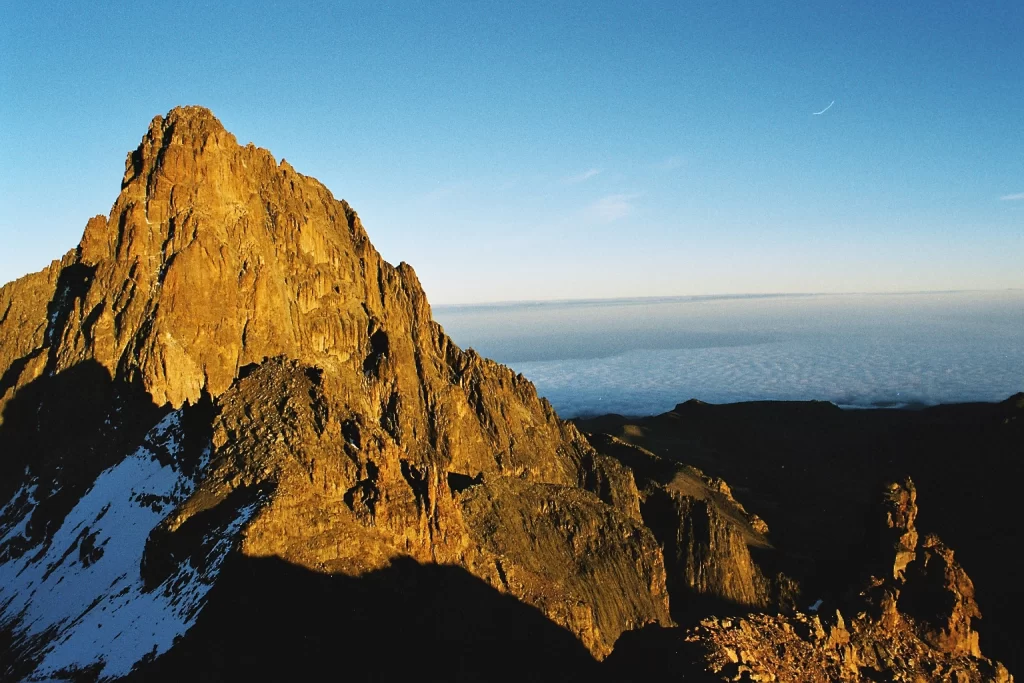Mount Kenya is Kenya’s highest mountain and also the second highest (slightly lower than Mount Kilimanjaro) in the African continent. Mount Kenya is situated in the Central and Eastern part of the Republic of Kenya.
Getting to Mount Kenya is a journey that covers around 200 kilometers (125 miles) northeast of Nairobi, Kenya’s capital city. The slopes of Mount Kenya connect Kirinyaga, Nyeri, Embu, Tharaka Nithi and Laikipia Counties.
There are three peaks in Mount Kenya namely: Batian, Nelion and Lenana. The highest peak is Batian that is 5,199 meters (17,057 feet) high. Nelion and Batian are 5,133(17,021 feet) and 4,985 meters (16,355 feet) high respectively. Mount Kenya is 7,000 meters (23,000 feet) high.
Mount Kenya is famous for its breathtaking sceneries that surround the mountain. There are thick woodlands, lakes, tarns, mineral springs and a variety of rare endangered animal breeds. You can have an amazing view of the sharp cliffs and craggy peaks on your way from Nairobi on a clear non-cloudy day.
Here are important things to remember when planning to climb Mount Kenya.
- The Highest Peaks Of The Mountain Are Batian, Nelion & Point Lenana

Batian is the highest peak of Mount Kenya and it’s also the main summit which is 5,199 meters high. It is usually climbed by mountain lovers and experienced rock climbers. The best time to climb the Batian is July to September using the north face route. Another easier route to use is southwest ridge during the months of December to March.
Nelion is the second highest peak with 5,133(17,021 feet) and the most challenging to climb. You need to be an experienced rock climber because there are rocky surfaces to get to the peak. Point Lenana is the third summit in Mount Kenya. It is the easiest to climb because it doesn’t require technical skills. It is the most popular peak that most climbers have achieved.
- Mount Kenya Is A Challenging Climb But The Route You Choose Could Make A Difference
You can approach the peaks through the most scenic, longest and toughest route, Chogoria which takes 6 days to ascend and descend. This is a trekking route which has beautiful scenery.
Also, you can use the Sirimon Route which is less complicated and gentle. You can only take two days to get to the top of the mountain. To approach Point Lenana through this route you will scramble on ice and snow. You can also access the peaks by rock climbing. Rock climbing involves several factors like the length of the rope and confidence of the climbers, the size of the group climbing and local conditions.
Naromoru is the most direct route which takes two days though it has steep climbs. Most climbers use this route descending from the Mountain. It has more vegetation than the Sirmon Route. Climbers are cautioned not to use this route during the rainy season because it’s usually waterlogged.
The Burguret route is the less used route because it passes through the wilderness. It’s challenging to locate tracks through this route because vegetation has overgrown on the paths. It’s the best route for the hikers who love wilderness experience which takes two days to reach the top.
- There Are Several Huts Along The Various Routes Where You Can Acclimatize
As you hike Mount Kenya you will find several huts along the way depending on the route you use. Around the peak there is the Australian Hut, this is the highest hut on Mount Kenya followed by Howell Hut near Nelion peak.
There is the Two Turn Hut that is normally used in ascending Batian. It is located beside a lake. The Kami Hut is another hut that was used by climbers from the northern face of Batian.
You can also find huts along the Chogoria Route. These include Mount Kenya Lodge, Minto’s Hut and Urumandi Hut. Sirimon Bandas, the Warden’s Cottage and Meteorological Station are among the huts located along the Naromoru route.
There are also other campsites that you can acclimatize during your hike. These include McKinders, Old Moses Camp, or Shipton’s Camp with an extra cost of Kshs.5,000 per night. This cost covers shelter and food during your stay.
- The Complete Hike Should Take At Least 5 Days
Depending on the route you take, climbing Mount Kenya on average takes at least 5 days. Technical climbers take 8 days to reach the peaks. The duration of the hike depends on the experience that you want to get.
You will need the correct rock climbing gear and very warm clothes because the weather gets colder as you climb higher. Get used to your climbing gear prior to the real climbing exercise. If possible, hike hills and mountains to get used to altitude.
- You Should Seek The Guidance & Help Of An Experienced Climber As Well As A Porter
You will need an experienced porter for guidance and help during your journey. The costs for a porter and guide will depend on the route that you will use.
If you choose the Burguret – Chogoria route you will pay 975 EUR (1080 USD). For a journey of 4 or 5 days, it will cost 600 -700 EUR (700-800 USD) inclusive of porter and guide charges.
Some climbers prefer using vehicles to carry them for some distance of the journey as they trek up the remaining distance.
- Ensure You Are In Good Health And Physically Fit, The Hike Could Be Strenuous
Prior to climbing Mount Kenya, you should conduct a series of hikes to enable your body to get used to the walking and altitude. You must also be physically fit. Engage the services of an experienced guide to help you during your trip, especially if you suffer from altitude sickness.
Considering all these facts, climbing Mount Kenya is a memorable adventure. You can have an awesome experience of both hiking, unique wildlife and vegetation. You should include Mount Kenya in your travel list.
